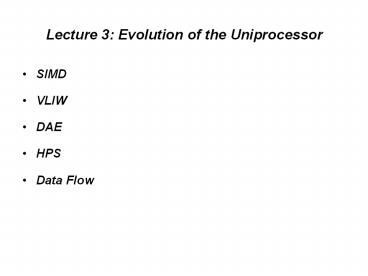Lecture 3: Evolution of the Uniprocessor PowerPoint PPT Presentation
Title: Lecture 3: Evolution of the Uniprocessor
1
Lecture 3 Evolution of the Uniprocessor
- SIMD
- VLIW
- DAE
- HPS
- Data Flow
2
(No Transcript)
3
(No Transcript)
4
(No Transcript)
5
(No Transcript)
6
The HPS Paradigm
- Incorporated the following
- Aggressive branch prediction
- Speculative execution
- Wide issue
- Out-of-order execution
- In-order retirement
- First published in Micro-18 (1985)
- Patt, Hwu, Shebanow Introduction to HPS
- Patt, Melvin, Hwu, Shebanow Critical issues
7
(No Transcript)
8
(No Transcript)
9
(No Transcript)
10
(No Transcript)
11
- The final flexibility Data Flow
12
(No Transcript)
13
(No Transcript)
14
(No Transcript)
15
Characteristics of Data Flow
- Data Driven execution of inst-level Graphical
code - Nodes are operators
- Arcs are I/O
- Only REAL dependencies constrain processing
- Anti-dependencies dont (write-after-read)
- Output dependencies dont (write-after-write)
- NO sequential I-stream (No program counter)
- Operations execute ASYNCHRONOUSLY
- Instructions do not reference memory
- (at least memory as we understand it)
- Execution is triggered by presence of data
16
- Why Data Flow?
- Irregular Parallelism
- Only real dependencies constrain
- Anti-dependencies dont
- Sequential I-stream doesnt (No Program Counter)
- Asynchronous (NOT in the sense of un-clocked)
- Why NOT Data Flow?
- In one word too much architectural state
17
Specific Problems with Data Flow
- Code bloat (everything is explicit)
- Code debug (asynchronous, non-deterministic flow)
- Interrupt handling (providing a consistent state)
- Machine diagnosis (trouble-shooting design
errors) - Recursion
- Large data structures
- Node table overflow (cost of CAM is high)
- Performance caveats
- Array copy operations
- Long latencies
- Network (bypass paths) congestion
PowerShow.com is a leading presentation sharing website. It has millions of presentations already uploaded and available with 1,000s more being uploaded by its users every day. Whatever your area of interest, here you’ll be able to find and view presentations you’ll love and possibly download. And, best of all, it is completely free and easy to use.
You might even have a presentation you’d like to share with others. If so, just upload it to PowerShow.com. We’ll convert it to an HTML5 slideshow that includes all the media types you’ve already added: audio, video, music, pictures, animations and transition effects. Then you can share it with your target audience as well as PowerShow.com’s millions of monthly visitors. And, again, it’s all free.
About the Developers
PowerShow.com is brought to you by CrystalGraphics, the award-winning developer and market-leading publisher of rich-media enhancement products for presentations. Our product offerings include millions of PowerPoint templates, diagrams, animated 3D characters and more.

